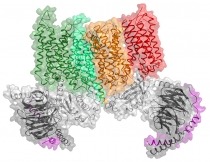Greens: CB1 receptors; Orange/Red: adenosine A2A receptors; Gray/purple: coupled G protein subunits
Glutamate is the most abundant excitatory neurotransmitter in our brain. It is involved in virtually every major excitatory brain function—when neurons fire to send messages through the brain. By strengthening or weakening signaling between neurons, glutamate plays a vital role in learning and memory. Learning how to manipulate this signaling could lead to new therapies for brain diseases, including addiction. This study from NIDA’s Intramural Research Program (IRP) constitutes a significant advance in the understanding of how to manipulate glutamate release by G protein-coupled receptors (GCPRs), a large family of receptors that facilitate cell communication throughout the body.
It has been long known that cannabinoids inhibit glutamate release in the brain, and scientists have assumed that cannabinoids exert this effect by direct activation of inhibitory GPCRs. In a molecular and functional study using computational modeling, the IRP scientific team has discovered that, at least in the brain area known as the striatum, the mechanisms by which cannabinoids inhibit glutamate release are more complex. Indeed, they found that this process is controlled by the neurotransmitter adenosine and mediated by complexes (heteromers) of receptors for both cannabinoids and adenosine. More specifically the adenosine receptors correspond to the A2A subtype. These findings indicate that compounds with the ability to block adenosine A2A receptors should counteract some of the deleterious effects of cannabinoids.
This research represents a significant conceptual advance in the field of the GPCR physiology and pharmacology and suggests the possible use of A2A receptor antagonists to counteract the adverse effects of cannabinoids. It is also part of ongoing research at NIDA’s IRP into the brain’s exquisitely complicated GPCRs, which play a key role in brain signaling underlying addiction and other behaviors.
Study:
- Attila Köfalvi, Estefanía Moreno, Arnau Cordomí, Ning-Sheng Cai, Victor Fernández-Dueñas, Samira G. Ferreira, Ramón Guixà-González, Marta Sánchez-Soto, Hideaki Yano, Verònica Casadó-Anguera, Rodrigo A. Cunha, Ana Maria Sebastião, Francisco Ciruela, Leonardo Pardo, Vicent Casadó and Sergi Ferre. Control of glutamate release by complexes of adenosine and cannabinoid receptors. BMC Biology.
